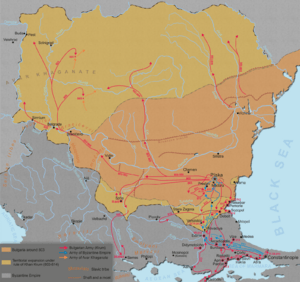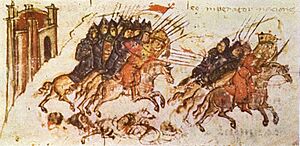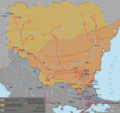Battle of Versinikia facts for kids
Quick facts for kids Battle of Versinikia |
|||||||
|---|---|---|---|---|---|---|---|
| Part of the Byzantine-Bulgarian Wars | |||||||
 Bulgaria under Khan Krum including the most important campaigns and battles |
|||||||
|
|||||||
| Belligerents | |||||||
| Bulgarian Empire | Byzantine Empire | ||||||
| Commanders and leaders | |||||||
| Khan Krum | Michael I Rangabe | ||||||
| Strength | |||||||
| 6,000–7,000 or 12,000 | 20,000–30,000 30,000–36,000 |
||||||
| Casualties and losses | |||||||
| Unknown | 2,000–3,000 | ||||||
The Battle of Versinikia (Bulgarian: Битката при Версиникия; Greek: Μάχη της Βερσινικίας) was a major battle fought in 813. It took place between the Byzantine Empire and the Bulgarian Empire. The fight happened near the city of Adrianople (today known as Edirne) in modern-day Turkey.
The Bulgarian army, led by their powerful ruler, Khan Krum, won the battle. This was a big victory, especially since the Bulgarian force was much smaller than the Byzantine army. This defeat caused the Byzantine Emperor Michael I Rangabe to lose his throne. He was replaced by Leo V the Armenian. The Battle of Versinikia made Bulgaria even stronger, following their earlier victory over Emperor Nicephorus I in 811. After this win, Bulgaria gained control of much of Eastern Thrace. For the first time, the Bulgarians could even march towards Constantinople, the Byzantine capital. However, Khan Krum died in 814 while preparing for this big attack.
Contents
Why the Battle Happened
Byzantine Troubles After Pliska
After the Bulgarians defeated the Byzantine army in the Battle of Pliska in 811, the Byzantine Empire faced many problems. Emperor Nicephorus I was killed in that battle. His son, Staurakios, who was supposed to take over, was badly hurt. He was removed from power later that year. Michael I Rangabe, a palace official, then became the new Byzantine Emperor.
Bulgarian Recovery and Attacks
Bulgaria also suffered losses in the Battle of Pliska. They needed time to rebuild their army and gather resources. So, they didn't immediately attack again. When they did, their attacks focused on the region of Thrace. They also raided along the Struma River. Many towns were captured, and their people were moved far north to Bulgarian lands across the Danube River. This caused a lot of fear among the Byzantines. Some people even ran away from their towns before the Bulgarians arrived.
Emperor Michael I tried to gather an army to stop the Bulgarians. But he had to return to Constantinople because of problems within his own government.
Peace Talks Fail
The Bulgarians continued their attacks in Thrace. In the autumn of 812, they offered peace to the Byzantines. A Bulgarian leader named Dobromir led the peace talks. However, the Byzantine Emperor refused to agree to a peace deal. One big reason for this was an old treaty from 716. This treaty said that both sides had to return people who had run away or deserted. This rule was not good for the Byzantines at this time.
Because the peace talks failed, the Bulgarians attacked the city of Mesembria (Nessebar). They used special siege machines built by an Arab engineer. They quickly captured the city. Inside Mesembria, they found valuable items. These included 36 copper siphons used to throw Greek fire, a powerful weapon. They also found a lot of gold and silver.
Preparing for Battle
Byzantine Refusal and Bulgarian Raids
Even after losing Mesembria, the Byzantines still refused to make peace. During the winter of 812–813, Khan Krum started getting ready for a big attack on the Byzantine Empire. Emperor Michael I also prepared his defenses.
In February 813, Bulgarian forces made some quick raids into Thrace. They pulled back after small fights with the Byzantines. Emperor Michael I saw this retreat as a victory from God. This encouraged him to plan a counter-attack.
Byzantine Army Gathers
The Byzantines gathered a huge army from all parts of their empire. This included soldiers from different military districts called "themes". Even the guards from the Syrian mountain passes joined. The campaign was delayed due to some unrest among the soldiers. But in May, the army finally left Constantinople.
The departure was a big event. People from the city, including the Empress, came to see the troops off. They gave gifts to the army leaders. They asked them to protect the Emperor and fight for the Christians.
The Battle of Versinikia
March to Adrianople
The Byzantine army marched north. They did not try to take back Mesembria. On May 4, a solar eclipse happened. This scared the Byzantine soldiers and lowered their spirits. They set up camp near Adrianople. While there, the army looted and robbed their own country.
In June, Khan Krum also arrived near Adrianople. Both armies set up their camps close to each other. They were near a small fortress called Versinikia, north of Adrianople.
Waiting Game
According to the historian John Skylitzes, the Byzantine army was much larger than the Bulgarian army. Because of this, the Bulgarians stayed in a defensive position. Even though the Byzantines had more soldiers and better supplies, they did not attack. Both armies waited for thirteen days during the hot Thracian summer.
Finally, the Byzantine commanders decided to attack. On June 22, a general named John Aplakes, who led the forces from Macedonia, spoke to Emperor Michael. He said, "How much longer will we wait and die? I will attack first in God's name. You must follow me bravely. We will win because we are ten times more than them."
The Fight Begins
The right side of the Byzantine army, led by Aplakes, attacked the left side of the Bulgarian army. Aplakes's soldiers managed to hurt the Bulgarians and push them back. However, the middle and left parts of the Byzantine army did not join the fight. This left Aplakes's attack without support.
When Khan Krum saw that the Byzantine center and left were not moving, he acted quickly. Krum ordered a second line of Slavic foot soldiers to fight Aplakes's group. At the same time, a unit of Bulgar horse archers and heavy cavalry attacked both sides of Aplakes's soldiers.
Byzantine Retreat
The soldiers from the Anatolian theme were the first to run away. Soon, the entire Byzantine army followed. Aplakes's soldiers were left behind, and most of them died, including their commander.
When the Bulgarians saw the enemy retreating, they first thought it was a trick. They didn't expect to win so easily, so they didn't chase them right away. But when the Bulgarians realized the enemy was truly fleeing, their heavy cavalry rushed after the Byzantines. Some Byzantines died while running. Others hid in fortresses, some of which the Bulgarians captured. The rest managed to reach Constantinople. The main Byzantine commanders, including Emperor Michael I Rangabe and Leo the Armenian, were among the first to leave the battlefield. The Bulgarians took the Byzantine camp, finding gold and weapons.
Later Byzantine historians blamed Leo the Armenian for the defeat. They claimed he purposely ordered his units to run away, even though they hadn't fought yet. Many modern historians agree with this view. However, some scholars believe Leo was not responsible.
Aftermath of the Battle
Emperor Michael Abdicates
The victory at Versinikia made the Byzantine Empire's situation much worse. It gave the Bulgarian Khan a chance to attack near the Byzantine capital itself. The battle also decided the fate of Emperor Michael I Rangabe. He was forced to give up his throne and go to a monastery.
Leo V the Armenian (who ruled from 813 to 820) became the new Byzantine Emperor. He was known as a strong and energetic leader. He immediately took quick steps to defend Constantinople. He expected a Bulgarian attack.
Krum Reaches Constantinople
The path to Constantinople was now open. The Bulgarian army marched towards the city without meeting much resistance. A few fortresses in Thrace were still held by the Byzantines. Adrianople, for example, was besieged by Krum's brother.
On July 17, 813, Krum himself reached the walls of Constantinople. He set up his camp without any trouble. In full view of the people of Constantinople, Krum performed some pagan rituals. He made a sacrifice to the Bulgar god Tangra. He also built trenches along the city's walls and offered peace.
Byzantine Treachery
Emperor Leo V agreed to talk. However, he secretly planned to kill Khan Krum. During the negotiations, the Byzantines fired arrows at the Bulgarian group. Some of them were killed, including a high official called the kavkhan. But Krum himself was not hurt.
Krum was furious about this betrayal. He ordered all churches, monasteries, and palaces outside Constantinople to be destroyed. Captured Byzantines were killed. Treasures from the palaces were sent to Bulgaria on carts. Next, enemy fortresses near Constantinople and the Marmara Sea were captured and torn down. The towns and villages in Eastern Thrace were robbed, and the whole region was ruined.
Adrianople Falls
Krum later returned to Adrianople and made the siege stronger. With the help of mangonels (large stone-throwing machines) and battering rams, he forced the city to surrender. The Bulgarians captured 10,000 people from Adrianople. These people were moved to Bulgarian lands across the Danube. Another 50,000 people from other towns in Thrace were also sent there.
During the winter, Krum went back to Bulgaria. He started serious preparations for a final attack on Constantinople. He planned to transport siege machines to Constantinople using 5,000 iron-covered carts. These carts would be pulled by 10,000 oxen. However, Khan Krum died on April 13, 814, while these preparations were at their peak.
Where Was the Battle?
The exact location of the Versinikia fortress is not known for sure. According to an old text by Theophanes, the castle was about 60 kilometers (about 37 miles) from Emperor Michael Rangabe's camp at Adrianople.
At that distance to the north is the village of Malomirovo. An old Bulgarian inscription from Khan Krum's time was found nearby. This inscription talks about how the Bulgarian army was divided during the 813 campaign. The left side, led by the kavkhan Irtais, was near the coast at Anchialus (Pomorie) and Sozopol. The right side, led by the ichirgu-boil Tuk, was in the area of Beroe (Stara Zagora).
Khan Krum's main force was probably in the area of the modern town of Elhovo, which is close to Malamirovo. It is likely that the Byzantine army took its position along the Derventski Heights. These heights are located on the current border between Bulgaria and Turkey.
Images for kids





